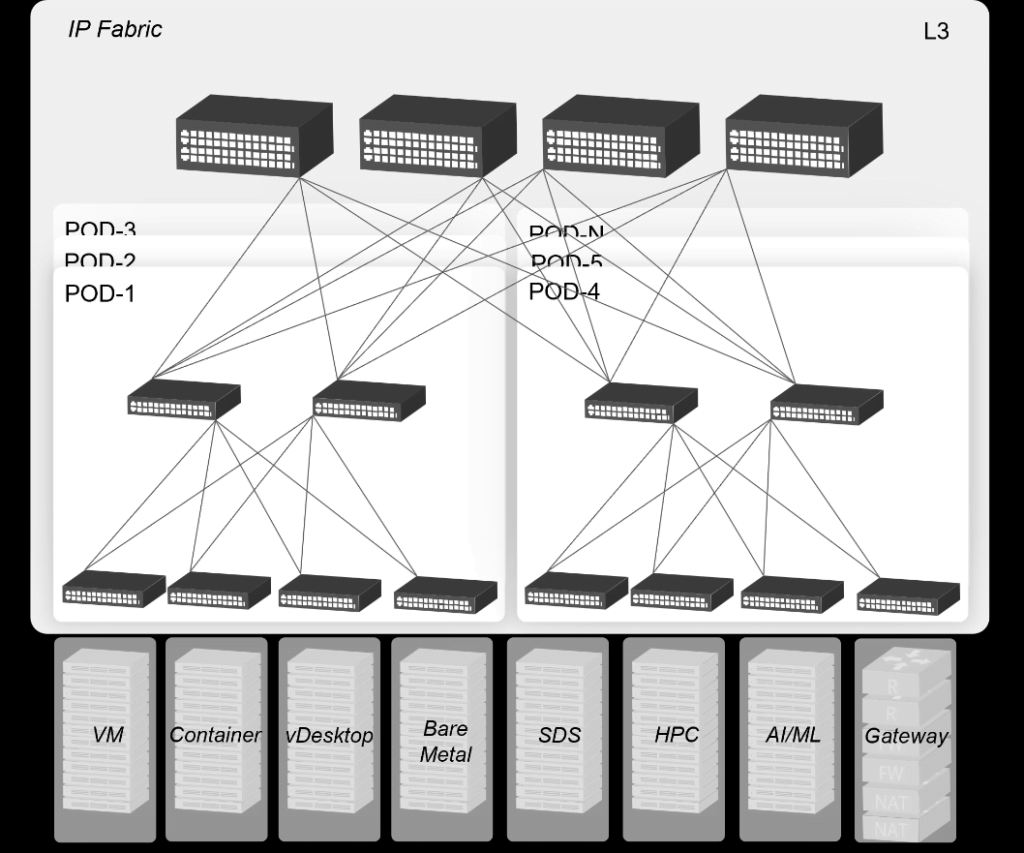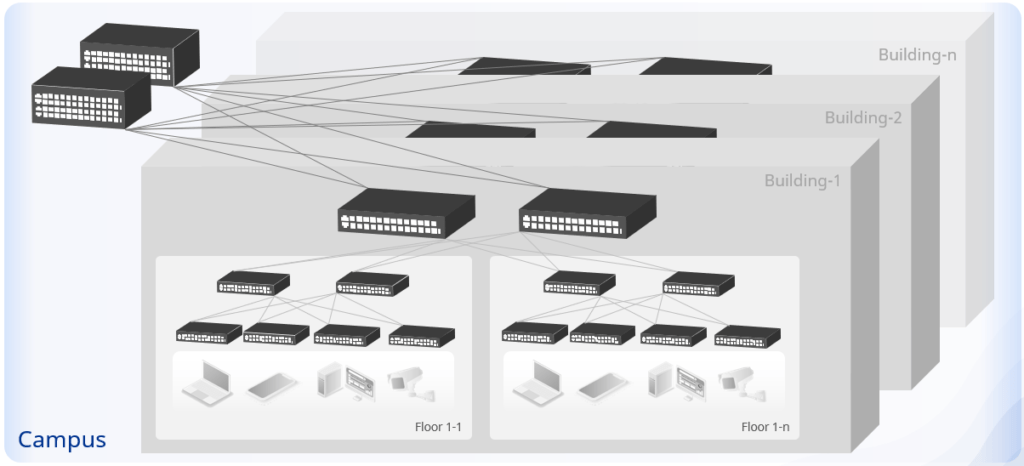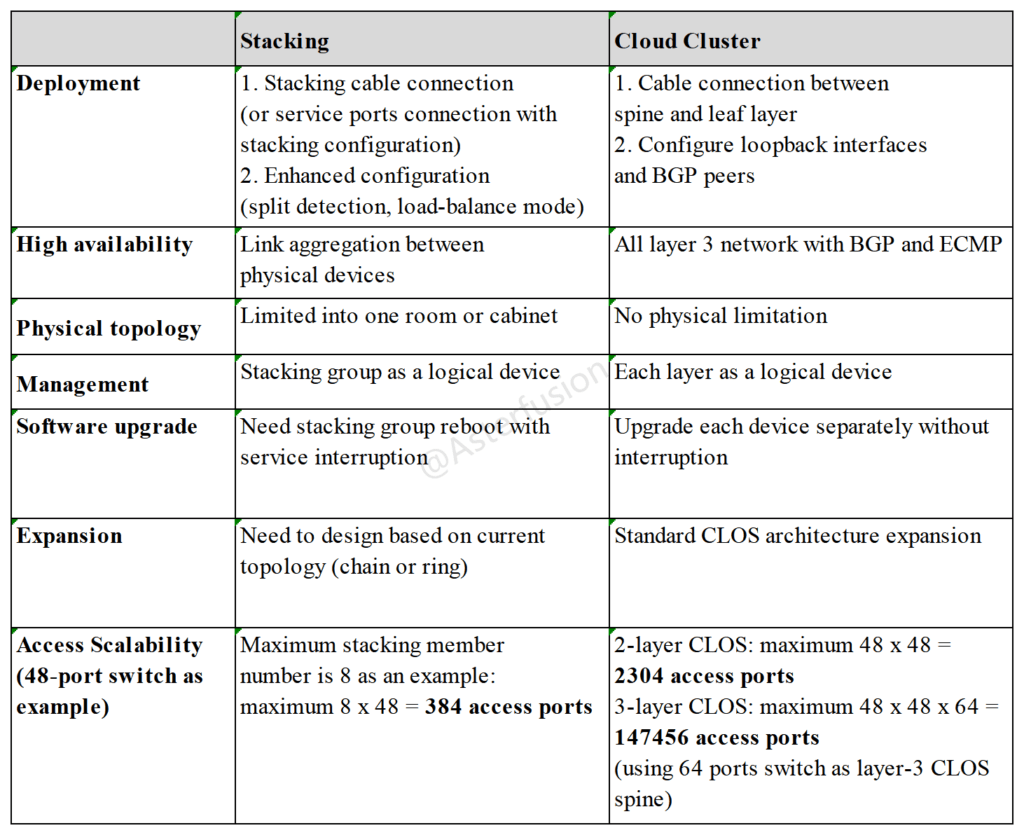During the early stages of cloud computing development, the cloud network architecture was modeled after the traditional campus network. However, market demand has driven the cloud network to undergo significant changes over the past two decades. Today, the cloud network has surpassed the traditional campus network in terms of network architecture, hardware equipment, scalability, and operation& maintenance capabilities. If the advanced network architecture and technical highlights of the cloud are introduced to the campus, what changes will it bring?
This article will explore how Asterfusion’s new cloud cluster campus network addresses the shortcomings of the traditional stack architecture to achieve even higher reliability and scalability.
What is Stack Network Architecture?
In the traditional campus network, stacking technology is often used to provide highly reliable access services for some terminals. This method virtually combines two or multiple physical switches of the same specification into one switch, allowing terminals to be connected to different access switches through distinct lines. When a switch fails, another one automatically takes over the process of network traffic, hence assuring the connection between user devices and network. Stacking architecture can be employed on higher layer switches or even between switches at different layers.
limitations of Stacking
The advantages of stacked architecture, which was introduced in 1990s, which are still very important nowadays, but as the wired, wireless and IoT devices are growing fast, traditional stack architectures are facing several drawbacks for the next-generation campus network:
- Inherent limitation: Stacking is not a standard protocol, different vendors use different cables, connectors and software in their stackable switches, and even different switches from a same vendor cannot be stacked. When the switch in the stack has stopped selling, but the user still needs to expand, it must be replaced as a whole.
- Limited bandwidth: Most vendors limit the number of stack members due to the stacking bandwidth limitation. Moreover, it is confusing that vendors have different ways to report stacking bandwidth. For example, some vendors count stacking bandwidth separately for each direction, which may mislead the customers to believe they have twice as much bandwidth as they actually have.
- Stack split: Expanding or removing a stack member could cause a service interruption because the process requires a reboot of all the stack members. When failure or wrong operation happens, the stack may be divided into 2 or more stacks.
- Software impact: Running the stack will add much complexity to the software (stack management, etc.). In reality, a stack is fate-sharing, software issues may cause the entire stack failure.
- Physical topology limitation: For timing requirement of the control plane and bandwidth consideration, stackable switches use proprietary stacking cables, which limit the distance and topology of stack members into one room or even one cabinet.
Asterfusion’s next generation Cloud Cluster campus Solution
Today, Asterfusion has introduced cloud-based open architecture back to campus network. The CLOS based Spine-Leaf architecture retains the advantages of stacking ones and can also solve some drawbacks of them.
This solution eliminates the need for stacking complex networking logic, device configuration, and fragile state synchronization – the entire campus device network will function like a large virtual switch with thousands of access ports, all of which can be managed unified.

- No alterations are necessary for the access terminal to link up to different access Leafs via two (or more) lines, as it employs the standard Bond technology;
- Through ARP learning, 32-bit host routing, and BGP synchronization to leverage the superior reliability and multi-path features of the L3 network, allowing for comparable efficiency as traditional stacking;
- Does not involve complex stacking software development, thus the system’s stability is high, and no potential bugs will result from complex stacking logic;
- By using the ECMP load sharing capability of the L3 network, all the bandwidth between switches can be fully utilized to transmit messages, leading to higher network performance.
De–Stacking: 3-Layer Leaf -Spine CLOS Architecture In Campus
After the interconnection and registration configurations finish, the cloud cluster established and the switches working in the same layer will work as a logical switch with a unified management interface (just like stacked systems), where the cluster members’ configurations are automatically synchronized.

When new members added to the cluster, only registration work is necessary. Due to the
Spine-Leaf architecture, the scale of the cluster can be very large without worry about
stacking bandwidth. For example, in a stacking system of 48-port access switch, the
maximum number of downlink ports is 48×8 (stack member limitation), but in cloud cluster,
the number can be easily extended to 48×48, even 48x48x64 in a 3-layer CLOS architecture.

Discard Layer 2 – get a full Layer 3 IP Fabric
In traditional layer-2 campus network, many complicated features are deployed to avoid the
risks such as ethernet loop and broadcast storm. Asterfusion cloud cluster adopts all layer-3
network to naturally avoid the above risks. Moreover, compared with the layer-2 network
running STP, it can take full use of the network resource.

For simplicity consideration, cloud cluster adopts unified BGP instead of complex IGP+EGP
structure. MP-BGP or EVPN is used to synchronize the routing information between different
subnets and distributed gateways. Using the ECMP load sharing capability of the L3 network,
all the bandwidth between switches can be fully utilized to transmit packets, making the
network performance higher.

Comparison between Stacking & Cloud Cluster
Now we can make a simple comparison between stacking architecture and cloud cluster in
terms of deployment and O&M aspects, the obviously advantages of cloud cluster are bold
marked:

Asterfusion’s cloud-based campus network solution has not only de-stacking capabilities, but also multiple levels of innovation. With the help of open cloud network technology and architecture, we will be able to develop the campus network from architecture to construction to operation &maintenance. The owners and operators of campus networks will benefit most from all of these changes: reduce network construction costs, improve network efficiency, and support unlimited innovation.



